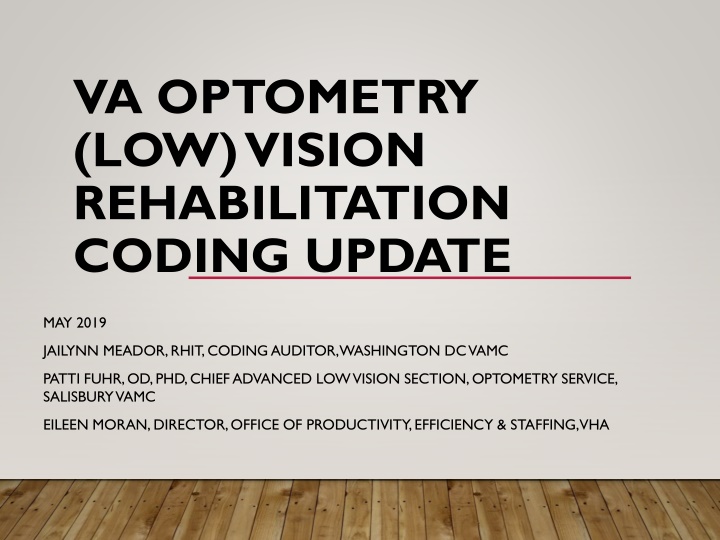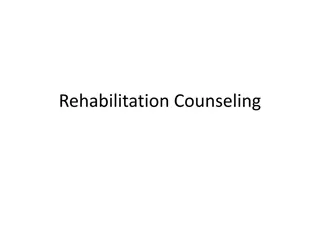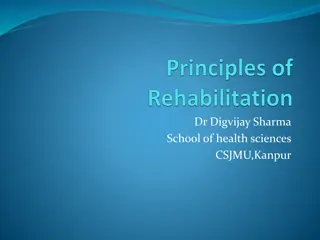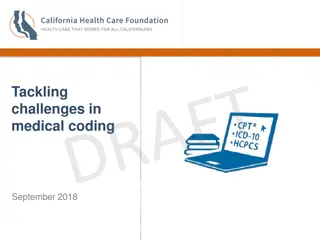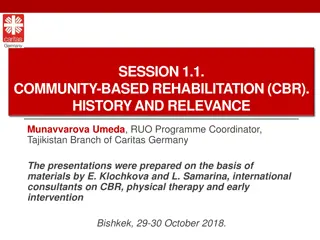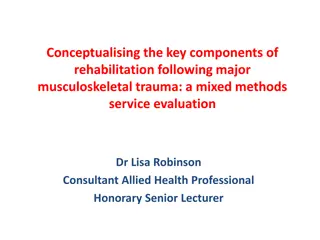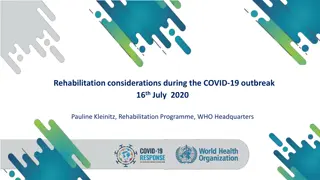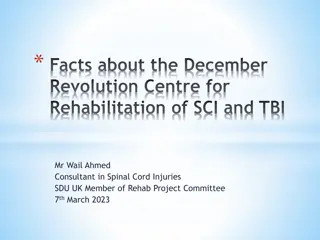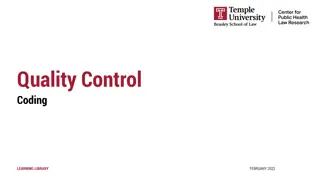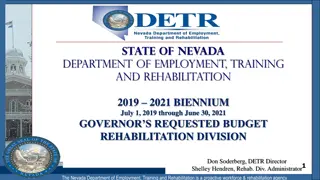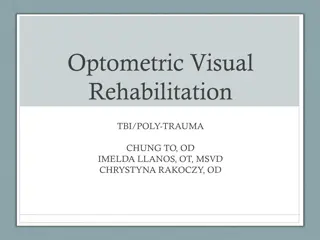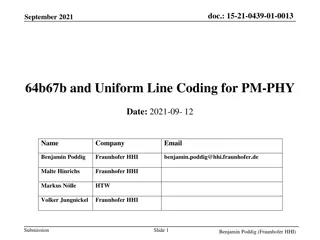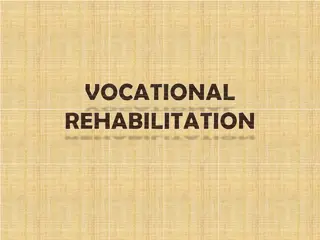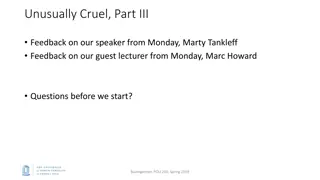Low Vision Rehabilitation and Coding Update May 2019
Comprehensive examination and treatment in low vision rehabilitation require careful consideration of counseling, device training, and medical decision-making complexity. Coding by time may be necessary, with proper documentation essential for reaching higher levels of care. Insights on low vision examinations are shared from Optometry, Ophthalmology, and Coders, highlighting the importance of accurate billing practices and thorough patient counseling.
Download Presentation

Please find below an Image/Link to download the presentation.
The content on the website is provided AS IS for your information and personal use only. It may not be sold, licensed, or shared on other websites without obtaining consent from the author.If you encounter any issues during the download, it is possible that the publisher has removed the file from their server.
You are allowed to download the files provided on this website for personal or commercial use, subject to the condition that they are used lawfully. All files are the property of their respective owners.
The content on the website is provided AS IS for your information and personal use only. It may not be sold, licensed, or shared on other websites without obtaining consent from the author.
E N D
Presentation Transcript
VA OPTOMETRY (LOW) VISION REHABILITATION CODING UPDATE MAY 2019 JAILYNN MEADOR, RHIT, CODING AUDITOR, WASHINGTON DC VAMC PATTI FUHR, OD, PHD, CHIEF ADVANCED LOW VISION SECTION, OPTOMETRY SERVICE, SALISBURY VAMC EILEEN MORAN, DIRECTOR, OFFICE OF PRODUCTIVITY, EFFICIENCY & STAFFING, VHA
LOW VISION REHABILITATION Comprehensive low vision rehabilitation examination and treatment is time intensive How much counseling do we provide? How does device training count? What complexity of medical decision making are we performing? Can we reach level 5? Should we code by time?
LOW VISION REHABILITATION EXAMINATION Our documentation may not reflect all the care that is being provided in low vision examination The following slides incorporate important aspects of LVE from the views of Optometry, Ophthalmology, and Coders
LOW VISION REHABILITATION EXAMINATION Low vision evaluations may be billed under Evaluation and Management codes (99201-99205) If more than half of the total time is devoted to counseling and advising the patient, billing may be according to time spent, although levels of care and complexity of decision-making should be documented. The American Academy of Ophthalmic Executives: Vision Rehabilitation Coding 2012
COUNSELING Counseling is a discussion with a patient and/or family concerning one or more of the following areas: Diagnostic results, impressions and/or recommended diagnostic studies Prognosis Risks and benefits of management (treatment) options Instructions for management (treatment) and/or follow-up Importance of compliance with chosen management (treatment options) Risk factor reduction Patient and family education ACOI
COORDINATION OF CARE Care coordination is the deliberate organization of patient care activities between two or more participants involved in a patient's care to facilitate the appropriate delivery of health care services. American Medical Association
NEW VS ESTABLISHED PATIENT *FOR CODING PURPOSES: New patients for VA and outside facilities are all greater than 3 years or never seen at the facility If the patient has been seen within last 3 years, they would be considered established FOR SCHEDULING PURPOSES: New patient if the Veteran was not seen in your STOP CODE at YOUR FACILITY within the past 2 years See notes page for further information
JAILYNN MEADOR, RHIT CODING AUDITOR, WASHINGTON DC VAMC
CODING LOW VISION REHABILITATION EXAMINATION E&M Codes 99000 Based on Key Components: History, Exam, and Medical decision making Plus ophthalmic procedure codes if medically necessary Plus rehabilitation procedure codes Once the treatment plan has been established
MEDICAL DECISION MAKING 1. Determined by the number of diagnoses or management options 2. Amount and/or Complexity of data 3. Risk of complications The American Academy of Ophthalmic Executives: Vision Rehabilitation Coding 2012
COMPLEXITY OF MEDICAL DECISION MAKING (CODING COUNCIL) Number of Diagnoses or Management Option Minimal Limited Multiple Extensive Amount and/or Complexity of Data to be Reviewed Minimal or None Limited Moderate Extensive Risk of Complications and/or Morbidity or Mortality Minimal Low Moderate High Type of Decision Making Straightforward Low Complexity Moderate Complexity High Complexity
MEDICAL DECISION MAKING Straightforward: Minimal number of diagnoses or management problems, Minimal or low amount and/or complexity of data Minimal risk of complications The American Academy of Ophthalmic Executives: Vision Rehabilitation Coding 2012
MEDICAL DECISION MAKING Straightforward: Example: Complains only of difficulty reading newsprint, impairment = blurred vision, no scotomas; minimal contrast sensitivity loss, no suspicion of depression, problem resolved with higher add and/or light The American Academy of Ophthalmic Executives: Vision Rehabilitation Coding 2012
MEDICAL DECISION MAKING Low Complexity: Limited number of diagnoses or management problems, Limited or low amount and/or complexity of data Low risk of complications The American Academy of Ophthalmic Executives: Vision Rehabilitation Coding 2012
MEDICAL DECISION MAKING Low Complexity: Example: Complains of difficulty reading all small print and seeing signs when driving; small paracentral scotoma in one eye not interfering with fixation or reading, dense central scotoma in other; mod contrast loss; requires device for reading, filters, advice on driving, may require OT, scotoma training The American Academy of Ophthalmic Executives: Vision Rehabilitation Coding 2012
MEDICAL DECISION MAKING Moderate Complexity: Multiple number of diagnoses or management problems, Moderate or low amount and/or complexity of data Moderate risk of complications The American Academy of Ophthalmic Executives: Vision Rehabilitation Coding 2012
MEDICAL DECISION MAKING Moderate Complexity: Example: Complains of difficulty with all reading, ADLs at home, transportation, shopping; central or ring scotomas OU or paracentral in one eye interfering with reading; moderate to severe contrast loss; multiple medical issues (e.g., arthritis, risk of falls, CBS, hearing, depression); discouraged; requires range of devices and filters; requires OT training The American Academy of Ophthalmic Executives: Vision Rehabilitation Coding 2012
MEDICAL DECISION MAKING High Complexity: Extensive number of diagnoses or management problems, Extensive or low amount and/or complexity of data High risk of complications The American Academy of Ophthalmic Executives: Vision Rehabilitation Coding 2012
MEDICAL DECISION MAKING High Complexity: Example: Complains of difficulty with all reading, ADLs at home, transportation, shopping; central scotomas OU; severe contrast loss; multiple medical issues as above; no support system and/or primary caretaker of spouse; high risk for depression; requires range of devices, strategies, OT training The American Academy of Ophthalmic Executives: Vision Rehabilitation Coding 2012
POCKET GUIDE NEW PT (CODING COUNCIL) EM 3/3 New/Consult *Time History Exam 95 Medical Decision Making 99201/99241 Problem Focused 10/15 M CC 1 HPI 1 Body System Minor Straightforward Complexity 99202/99242 Expanded Problem Focused 20/30 M CC 1 HPI 1ROS 2 Body Systems Low Severity Straightforward Complexity 99203/99243 Detailed 30/40 M CC 4 HPI 2 ROS 1 PFSH 5 Body Systems 2 DX or 1 new Dx or 1 worse DX (consult/ Med Change ) Low Complexity 99204/99244 Comprehensive 45/60 M CC 4 HPI 10 ROS 3 PFSH 8 Body Systems 3 Dx or 2 Dx (1 worse, consult/ med change ) or 1 new DX (worse, consult/ Med change ) Moderate Complexity 99205/99245 Comprehensive 60/80 M CC 4 HPI 10 ROS 3 PFSH 8 Body Systems 2 Dx (2 worse elective open surgery) or 1 New Dx (worse elective open surgery) High Complexity
POCKET GUIDE ESTABLISHED PT (CODING COUNCIL) EM 2/3 Established *Time History Exam 95 Medical Decision Making 99212 Problem Focused 10 M CC 1 HPI 1 Body System Minor Straight Forward Complexity 99213 Expanded Problem Focused 15 M CC 1 HPI 1ROS 2 Body Systems 2 Dx or 1 Worse DX (consult/ Med Change ) or 1 New DX (stable) Low Complexity 99214 Detailed 25 M CC 4 HPI 2 ROS 1 PFSH 5 Body Systems 3 DX or 2 DX (1 worse, consult/Med Change ) or 1 New DX (consult/Med Change ) Moderate Complexity 99215 Comprehensive 40 M CC 4 HPI 10 ROS 1 PFSH 8 Body Systems 2 Dx (2 worse, elective open surgery) or 1 New Dx (worse, elective open surgery) High Complexity
CONCEPT OF TIME Always record encounter start and stop time Record refraction time Record Counseling/Coordinating Time E&M Time = Total Encounter Time minus Refraction time minus other procedure time Use the time listed in CPT (typical time a physician spends with the patient and/or family) Documentation of time in the exam note is essential
RECORDING TIME Start time: ________ End time: ________ minus Refraction time: (-) _______ minus Special procedures time: (-) ________ = ______ minutes total time spent with patient, ______ minutes of which was spent on the above documented counseling and coordination of care.
EM CODING Code to the highest level that is met Document what you do so that coders can read and interpret it just as other practitioners do If you didn t document it, you didn t do it Remember to code for refraction and any special procedures that you performed
CODE FOR REHABILITATION ASSESSMENT & TRAINING Code only if YOU do it Must document in the record the amount of time you spent face-to-face with patient Time based, code for each 15 minutes Code only if you do it after your treatment plan has been established ASSESSMENT: 97755 Assistive Technology Assessment, Ea 15 Min (RVU = .62) May be used for evaluation of all prosthetic devices, not just computer-related, to restore, augment or compensate for existing function. TRAINING 97533 Sensory Integration Techniques, Ea 15 Min (RVU = .69) Sensory integrative techniques to enhance sensory processing and promote adaptive responses to environmental demands, direct one-on-one patient contact by the provider, each 15 minutes. Includes low vision or optical aid training, Eccentric viewing training, Manual skills sensory training, prism therapy
May be used with Eye Exam codes Description wRVU Rehab CPT Do not garner RVU when reported in addition to 92xxx codes Determine Refractive State 0.38 92015 Yes Assistive Technology Assessment, Ea 15 min 0.62 97755 Yes Cognitive Skills Development, Ea 15 min 0.44 97532 Yes Follow up for use of existing Prosthetic Device 0.25 97762 Yes Gait Therapy Training, Ea 15 min 0.4 97116 Yes Group Therapeutic Procedures 0.29 97150 NO Health Oriented Questionnaire 0.5 96150 NO LV Assessment, Ea 15 min LV Distance Viewing (TV, Faces, Signs, Etc.), Ea 15 min LV Intermediate Distance Recognition Tasks, Ea 15 min LV Re-assessment, Ea 15 min LV Spot & Continuous Text Reading, Writing, Etc., , Ea 15 min LV Visual Skills Training w/Devices, Ea 15 min 0.5 96150 NO 0.44 97533 Yes 0.44 97533 Yes 0.48 96151 NO 0.45 97535 Yes 0.44 97533 Yes LV Visual Skills Training w/o Devices, Ea 15 min 0.44 97533 Yes Manual Therapy 1/> Regions 0.43 97140 Yes Neuromuscular Reeducation (EV training) 0.45 97112 Yes Orthotic/Pleoptic Training 0.37 92065 Yes Polishing Artificial Eye 0 V2624 Yes Sensorimotor Exam 0.69 92060 Yes Team Conf w/o PT by Phys,+30 min 1.1 99367 NO Therapeutic Activities 0.44 97530 Yes Therapy/Exercise, Ea 15 min 0.45 97110 Yes PLEASE NOTE: 96150, 96151, 97150 and 99367 should not be used in addition to Eye Exam code, they are considered included
CONSULT CODES 99241-99245 Outpatient 99251-99255 Inpatient New or Established
CONSULT CODES In VA we are to code consultations with consult codes (see notes page below) Prolonged service codes may be used in conjunction with consult codes 99241-99245 For Inpatient Consults (may be applicable to BRCs or Polytrauma) only one consultation should be reported by a consultant per admission VA does not bill Medicare, providers are to code consultations with consult codes. Billers change them to the corresponding E/M level codes if need be. They have a cross walk. Check with your local coders
PROLONGED SERVICES CODES Prolonged Services Definitions: In the office or other outpatient setting, Medicare will pay for prolonged physician services (CPT code 99354) (with direct face-to-face patient contact that requires one hour beyond the usual service), when billed on the same day by the same physician or qualified NPP as the companion evaluation and management codes. The time for usual service refers to the typical/average time units associated with the companion E&M service as noted in the CPT code. You should report each additional 30 minutes of direct face-to-face patient contact following the first hour of prolonged services with CPT code 99355. https://www.cms.gov/outreach-and-education/medicare-learning-network-mln/mlnmattersarticles/downloads/mm5972.pdf
PROLONGED SERVICES CODES In the inpatient setting, Medicare will pay for prolonged physician services (code 99356) (with direct face-to-face patient contact which require one hour beyond the usual service), when billed on the same day by the same physician or qualified NPP as the companion evaluation and management codes. You should report each additional 30 minutes of direct face-to-face patient contact following the first hour of prolonged services may be reported by CPT code 99357. https://www.cms.gov/outreach-and-education/medicare-learning-network- mln/mlnmattersarticles/downloads/mm5972.pdf
PROLONGED SERVICES CODES Note: You should not separately report prolonged service of less than 30 minutes total duration on a given date, because the work involved is included in the total work of the evaluation & management (E&M) codes. You may use code 99355 or 99357 to report each additional 30 minutes beyond the first hour of prolonged services, based on the place of service. These codes may be used to report the final 15 30 minutes of prolonged service on a given date, if not otherwise billed. Prolonged service of less than 15 minutes beyond the first hour or less than 15 minutes beyond the final 30 minutes is not reported separately. . https://www.cms.gov/outreach-and-education/medicare-learning-network- mln/mlnmattersarticles/downloads/mm5972.pdf
USING PROLONGED SERVICES CODES The encounter must first be scored (either by time or key components) and coded with appropriate E&M service code If based on key components, it means the documentation requirements for history, exam, and medical decision making have determined the level of E&M service If based on time, it means the highest level of E&M service in that code family has been selected based on the time in the table and that more than 50% of face-to-face time was spent on counseling/coordination of care Remember to document in the office note the amount of time spent face to face in counseling and coordination of care. https://www.cms.gov/outreach-and-education/medicare-learning-network- mln/mlnmattersarticles/downloads/mm5972.pdf
USING PROLONGED SERVICES CODES Rule of Halves Applicable to specific time-based codes As long as more than half of the assigned time is achieved the code can be reported For 99354 (60 minute assigned value) you must complete the first 31 minutes. Anything less than 31 minutes does not qualify for this code Do not use prolonged service code in addition to time-based counseling code or eye exam code 99354 and 99355 are only for direct contact time with the patient
HCPCS E&M LEVEL E&M Time wRVU Threshold time (minutes) to code 99354 40 50 60 75 90 99354 wRVU Threshold time (minutes) to code 99355 85 95 105 120 135 99355 wRVU per each 1.77 1.77 1.77 1.77 1.77 99201 Problem Focused New 99202 Expanded PF New 99203 Detailed New 99204 Comprehensive Mod New 99205 Comprehensive High New 99211 Orient/Educate 99212 Problem Focused Est 99213 Expanded PF Est 99214 Detailed Est 99215 Comprehensive Est CONSULTS 99243 Office Consult New or Est 99244 Office Consult New or Est 99245 Office Consult New or Est EYE EXAM LEVEL 92002 Int Eye Exam New Pt 92004 Comp Eye Exam New Pt 92012 Int Eye Exam Est Pt 92014 Comp Eye Exam Est Pt COMMON SPECIAL PROCEDURES 92015 Refraction 92340 Fit Single Vision 92341 Fit Bifocal 92341 Fit Multifocal 92370 Repair/Refit Glasses 92285 Ext Eye Photo 92250 Fundus Photo 92133 OCT ON/RNFL 10 20 30 45 60 0.45 0.93 1.42 2.43 3.17 1.77 1.77 1.77 1.77 1.77 not used by VA Optometrist 10 15 25 40 0.48 0.97 1.5 2.11 40 45 55 70 1.77 1.77 1.77 1.77 85 90 100 115 1.77 1.77 1.77 1.77 40 60 >80 1.88 3.02 3.77 70 90 110 1.77 1.77 1.77 115 135 155 1.77 1.77 1.77 n/a n/a n/a n/a 0.88 1.82 0.92 1.42 not applicable not applicable not applicable not applicable 92134 92081 92082 92083 97755 97112 97533 92060 OCT Post Seg/Mac Visual Field Screen (DMV) Visual Field Int (GVH) Visual Field Thresh(HVH) Assistive Tech Assess Neuromuscular ReEdu Sensory Integration Sensorimotor exam n/a n/a n/a n/a 0.45 0.3 0.4 0.5 0.62 0.5 0.48 0.69 n/a n/a n/a n/a n/a n/a n/a n/a 0.38 0.37 0.47 0.53 0.32 0.05 0.04 0.4 ea 15 min ea 15 min ea 15 min n/a
RESOURCES AOA.org Care of the Patient with Visual Impairment. Optometric Clinical Practice Guideline. American Optometric Association. 2007 Vision Rehabilitation Coding 2012 American Academy of Ophthalmic Executives, quotes with permission from Flora Lum, MD, AAO American Academy of Ophthalmology Vision Rehabilitation Preferred Practice Pattern 2017, quotes with permission from Flora Lum, MD, AAO https://www.acoi.org/sites/default/files/uploads/YoungTimeBasedCoding.pdf above https://www.cgsmedicare.com/partb/pubs/news/2018/07/cope8339.html
RESOURCES CMS.org https://www.cms.gov/Outreach-and-Education/Medicare-Learning- Network-MLN/MLNProducts/Downloads/eval-mgmt-serv-guide- ICN006764.pdf https://www.cms.gov/outreach-and-education/medicare-learning- network-mln/mlnmattersarticles/downloads/mm5972.pdf https://www.cms.gov/Outreach-and-Education/Medicare-Learning- Network-MLN/MLNMattersArticles/Downloads/MM9905.pdf https://www.cms.gov/Regulations-and- Guidance/Guidance/Transmittals/Downloads/R3678CP.pdf
LOOKING FORWARD CMS Patients over Paperwork initiative https://www.cms.gov/About-CMS/Story-Page/Clinician-Letter-Reducing-Burden- Documentation-and-Coding-Reform-.pdf https://www.cms.gov/About-CMS/Story-Page/patients-over-paperwork.html https://www.cms.gov/About-CMS/Story-Page/CY-19-PFS-Final-Rule-PPT.pdf
QUESTIONS One of the slides said that billing according to time should also include levels of care and complexity of decision making documentation. Could you please explain that?
QUESTIONS If you use time-based coding, do you have to do a complete review of systems, or can you just update the ROS?
QUESTIONS If an attending OD is supervising an optometry resident (Who is F2F with the patient the majority of the time and spends >1/2 of his time providing counseling/coordination of care), does the attending also have to spend >50% of her time counseling/coordinating care for the patient in order to code by time? As with any service Resident Supervision the amount of time that the resident is with the patient for counseling/coordination of care is what is reported for the E/M level code if it is greater than of the face to face time. The supervising provider does not have to spend that amount of time with the patient. Please review the following for documentation requirements per VHA Handbook 1400.01- Resident Supervision. As long as the requirements are met for documentation of Resident Supervision, there should not be an issue. (see notes page)
QUESTIONS I never bill as a consult, unless I m the provider who closes the consult. For example, often pt s see me and the VISOR therapists on the same day and they may end up linking their note to the consult b/c they saw them first, in which case I bill as a new patient (because I m not generating the consult report). Is this correct? *FOR CODING PURPOSES: New patients for VA and outside facilities are all greater than 3 years or never seen at the facility If the patient has been seen within last 3 years, they would be considered established
QUESTIONS I can remember years ago being cautioned against billing a 5 . . . do you think this still holds true? I can think of a handful I ve times I ve billed a low vision eval as a five based on either time or complexity, but I probably have a lot that meet the criteria for time. If your documentation meets the key factors or time-based criteria, you should code for what you do
QUESTIONS In the private sector I would bill based on time- typically level 4 or 5 exams and prolonged service codes when indicated. I have heard differing things on how to do this in the VA. Most commonly I have heard to bill intermediate exams and use LV codes for eval and what not in increments of 15 mins. What is your perspective on this? If your documentation meets the key factors or time-based criteria, you should code for what you do
QUESTIONS How many key components should one include if the plan is to bill on time? Should we be taking family and social history if the intention is not to level them (and bill on time instead)?
QUESTIONS Is there a code for extended refraction? No Can I add an additional refraction code for extensive near or intermediate refraction in addition to distance refraction? Yes, you do that by increasing the number of times the procedure was done in the encounter form, example on next slide
QUESTIONS Is it appropriate to do a slit lamp exam in addition to low vision evaluation in order to code properly for an eye exam? If you intend to bill based on eye examination, you must document the appropriate components of an eye exam, including slit lamp exam. You may bill additionally for special procedures such as gonioscopy, visual fields, photography. If you provide low vision examination and training, you may also include the rehab procedure codes, but only if the rehab was provided by YOU, AFTER the treatment plan has been established, and only if the time spent face-to-face with the patient on each rehab procedure was documented in the record. Remember, if using 92xxx codes, 96150, 96151, 97150, and 99367 should NOT be used, as they are considered included in the Eye Exam code
- Ive heard that you cant use device training as part of your billing for time b/c it s part of training not education is this true? I feel like there s a lot of overlap and when I actually get to the nuts and bolts of training, I don t include it as education but when I m going through device options, risk/benefits, etc. then I do. - Counseling on the purpose of the device, how to use it, pros and cons of the device, how to accomplish goals with the device, risks and benefits, and care of the device: all may be considered part of the time spent counseling patient, education is part of counseling - I know a couple of years ago there was some question about if low vision optometrist s workload was being captured correctly are there any updates on this based on what Patti showed, it looks like it s much more accurate than it was a few years ago on the back end and now it s up to us to make sure we re coding correctly.
- Can optometry bill for consults or is this governed by state? - Why can t optometry bill for 97110(Therapeutic Procedure, 1 or more areas, each 15 Minutes; Therapeutic Exercises to Develop Strength and Endurance, Range of Motion and Flexibility) with the appropriate documentation in the state of NY?
